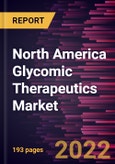Glycan-based products have wide applications in the therapeutic industry; the products are available in different structures & forms and developed as per the application. This drug is designed for various diseases, such as thrombosis, anaemia, cancer, influenza, cataract, and anti-inflammation. The glycoprotein is a type of glycan that can be used to deliver drugs, toxins, or radioactive substances directly to cancer cells. Monoclonal antibodies, including erythropoietin (EPO) and Herceptin (trastuzumab), are widely used and are a part of several research projects. These products are aimed at expanding and improving their applicability and efficacy. EPO has been used to treat traumatic brain injury (TBI) in young patients and Alzheimer's disease in rodent models due to its known neuroprotective effects. The largest and fastest-growing application category is drug discovery and development, mostly due to the rise in R&D by pharmaceutical and biotechnology firms and the expansion of drug discovery research activities in university research institutions.
For instance, in April 2020, researchers from the Institute for Glycomics and the University of Adelaide signed an exclusive licensing agreement with Sienna Cancer Diagnostics Ltd. to commercialize a cutting-edge cancer detection tool. The researchers have created SubB2M, a special protein that attaches itself exclusively to a sugar molecule, only found in cancer cells. The researchers have claimed that the protein might revolutionize cancer detection.
In March 2021, 48Hour Discovery (48HD) and CQDM announced that the firms received an award of US$ 800,000 for peptide drug development utilizing its unique drug discovery platform. The CQDM Quantum Leap initiative, which encourages research into cutting-edge technologies, methods, and platforms that speed up or expedite drug discovery and development, provided funding for the two-year study. Merck, a CQDM member, is financing the study. The University of Alberta and 48HD will work together on the project. Additionally, GlycoNet, a Network of Centres of Excellence centered at the University of Alberta for Glycomics Research, is providing the funds to enhance the quality of life of Canadians.
In March 2022, researchers from the Canadian Glycomics Network (GlycoNet) developed a novel combination medication for Sanfilippo syndrome, which is showing encouraging preclinical outcomes. Researchers at Kaleido Biosciences are developing therapeutics for immune-mediated and inflammatory diseases with synthetic glycans that are selectively metabolized in the gut microbiome to suppress the growth of bacteria associated with inflammation. One synthetic glycan candidate, KB295, is intended to treat ulcerative colitis, an inflammatory bowel disorder (IBD). The administration of microbiome-mediating glycans could radically improve treatment by 16% of IBD sufferers who do not respond to the current standard of care and other patients with hard-to-treat autoimmune and inflammatory conditions. These advancements show that glycomics has the potential to provide rapid and accurate therapeutic results for complex conditions. Therefore, the use of glycomics in drug development for diseases across the region drives the glycomics therapeutics market.
Market Overview
The North America glycomic therapeutics market is segmented into the US, Canada, and Mexico. The US held the largest share of the North America glycomic therapeutics market in 2022. The increasing demand in the region, followed by rising research and development activities by various major firms, rising number of investments in glycomic therapeutics research, and growing awareness about glycomic therapeutics, is expected to drive the overall glycomic therapeutics market during the forecast period.North America Glycomic Therapeutics Market Segmentation
The North America glycomic therapeutics market is segmented on the basis of class, structure, indications, mode of action, and country.- Based on class, the North America glycomic therapeutics market is bifurcated into isolated and synthetic. The synthetic segment registered a larger market share in 2022.
- Based on structure, the North America glycomic therapeutics market is segmented into glycoproteins, targeting sialic acid, proteoglycans, targeting glycosaminoglycans, glycosylphosphatidylinositol (GPI)-anchored proteins & heparin based glycans, targeting glycosphingolipids, and others. The glycoproteins segment held the largest market share in 2022.
- Based on indications, the North America glycomic therapeutics market is segmented into thrombosis & chemoprophylaxis, anaemia, anti-adhesive & anti-inflammatory, cataracts, gaucher’s disease, MPS-1 & IV, cancer, Alzheimer's disease, influenza type A & B, and others. The influenza type a & b segment held the largest market share in 2022.
- Based on mode of action, the North America glycomic therapeutics market is segmented into inhibits neuraminidase, inhibits heparanase and selectins and blocks interactions between growth factors and heparan sulfate, erythropoietin & enzyme replacement therapy (ERT), tissue plasminogen activator, inhibits glucosylceramide synthase, interleukin 1 and 2 and 3, beta & gamma interferons, and others. The erythropoietin & enzyme replacement therapy (ERT) segment held the largest market share in 2022.
- Based on country, the North America glycomic therapeutics market is segmented into the US, Canada, and Mexico. The US dominated the market in 2022. BioMarin Pharmaceutical Inc.; Genzyme Corporation (Sanofi); HalozymeTherapeutics, Inc.; Bayer AG; Alzheon, Inc.; GlycoMar; GlaxoSmithKline plc.; and F. Hoffmann-La Roche Lt. are the leading companies operating in the glycomic therapeutics in North America.
Table of Contents
Companies Mentioned
- Biomarin Pharmaceutical Inc.
- Genzyme Corporation (Sanofi)
- Halozyme Therapeutics, Inc.
- Bayer Ag
- Alzheon, Inc.
- Glycomar
- Glaxosmithkline Plc.
- F. Hoffmann-La Roche Ltd
Table Information
| Report Attribute | Details |
|---|---|
| No. of Pages | 193 |
| Published | November 2022 |
| Forecast Period | 2022 - 2028 |
| Estimated Market Value ( $ | $ 42.55 Million |
| Forecasted Market Value ( $ | $ 100.79 Million |
| Compound Annual Growth Rate | 15.5% |
| Regions Covered | North America |
| No. of Companies Mentioned | 8 |








